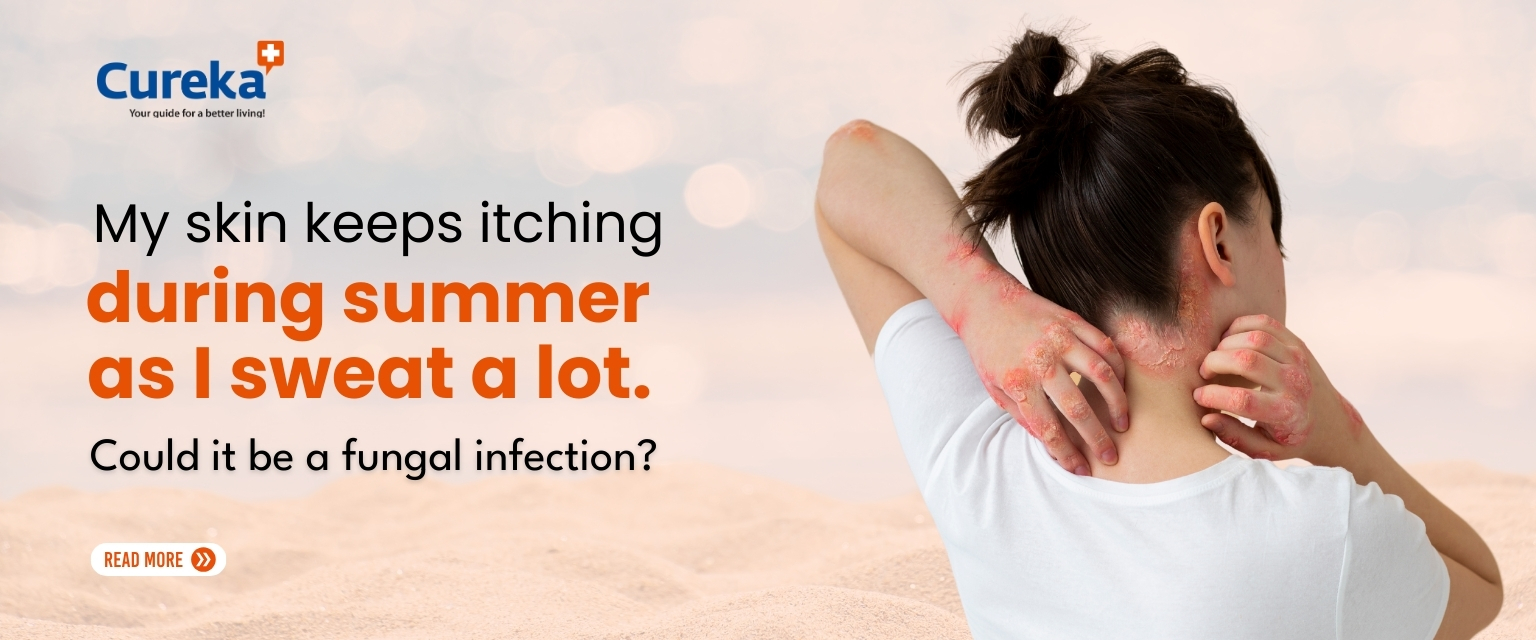My Skin Keeps Itching During Summer as I Sweat a Lot. Could It Be a Fungal Infection?
Summer brings sunshine, beach days, and outdoor fun but for many, it also brings an uncomfortable problem: skin itching. Are you constantly scratching your skin during the summer? You’re not alone. Skin itching in hot and humid weather is a common complaint. But when the itching becomes persistent especially in areas that sweat a lot it could be more than just heat rash. In many cases, it’s a sign of a fungal infection or other sweat-related skin infections like chafing, prickly heat, or intertrigo.
Let’s explore what causes these skin issues, how to identify them, and most importantly, how to prevent fungal infections caused by sweating.
Why Does My Skin Itch More in the Summer?
Sweating is your body’s natural way to cool down. But when sweat mixes with heat, humidity, friction, and tight clothing, it becomes the perfect recipe for skin irritation and infection. Sweat can clog pores, promote bacterial and fungal growth, and weaken your skin’s natural barrier. This leads to a variety of sweat-related skin infections, especially in skin folds and moisture-prone areas like the groin, armpits, under the breasts, and between toes.
Common Summer Skin Problems Caused by Sweat
Summer can trigger multiple skin conditions that result in skin itching, burning, and discomfort. Here’s a detailed look at the most frequent offenders:
1.Fungal Infections
Fungi love warmth and moisture. That’s why sweating makes you more prone to fungal infections during summer.
a) Tinea Pedis (Athlete’s Foot)
- Affects: Feet, especially between the toes
- Symptoms: Itching, peeling skin, redness, and a foul odor
- Cause: Sweaty socks, closed shoes, public showers
- Prevention: Use clotrimazole soap, wear breathable shoes, dry feet thoroughly
b) Tinea Cruris (Jock Itch)
- Affects: Inner thighs, groin, buttocks
- Symptoms: Itchy, red rash with a scaly border; may be ring-shaped
- Cause: Sweating, tight underwear, sharing towels
- Treatment: Apply clotrimazole powder or antifungal powder regularly
c) Tinea Corporis (Ringworm)
- Affects: Arms, legs, chest, and other body parts
- Symptoms: Circular, red, itchy patches with defined edges
- Cause: Direct skin contact or contaminated clothing
Note: It’s highly contagious and can spread quickly in summer
2.Prickly Heat (Miliaria)
- Affects: Neck, chest, back, and under breasts
- Symptoms: Tiny red bumps, prickling or stinging sensation
- Cause: Sweat gets trapped in blocked sweat ducts
- Risk Groups: Infants, athletes, and those wearing heavy clothing in heat
- Prevention: Use cooling powders, wear loose clothes, keep skin dry
- Relief: Apply calamine lotion, aloe vera gel, or other soothing anti-inflammatory agents like chamomile, cucumber extract, or colloidal oatmeal to calm irritated skin.
3.Chafing (Intertrigo)
- Affects: Inner thighs, groin, armpits, under breasts
- Symptoms: Red, sore, raw patches that may burn or sting
- Cause: Friction + sweat = skin breakdown
- Risk: Obesity, tight clothing, and vigorous activity
- Danger: When left untreated, it can turn into a fungal infection
- Management: Use antifungal powders, barrier creams, and wear moisture-wicking fabrics
4.Folliculitis
- Affects: Hair-bearing areas like thighs, buttocks, back
- Symptoms: Red, inflamed hair follicles that may resemble acne
- Cause: Sweat and bacteria clogging follicles
- Risk: Wearing synthetic clothing or sitting in wet clothes too long
- Prevention: Shower after sweating and use clotrimazole soap if fungal folliculitis is suspected
5.Body Odor & Bacterial Infections
- Affects: Underarms, feet, groin
- Cause: Bacteria breaking down sweat molecules
- Risk: Wearing non-breathable clothes, poor hygiene
- Prevention: Daily bathing, use of antibacterial or antifungal soaps, and dry clothing
6.Erythrasma (often mistaken for fungal infection)
- Affects : Groin, armpits, toe webs
- Symptoms : Red-brown, slightly scaly patches
- Cause : Bacterial overgrowth (Corynebacterium)
- Fun Fact : It glows coral-pink under UV light!
- Treatment: Antibiotic creams or antibacterial washes not antifungals
How to Prevent Fungal Infections Caused by Sweating
Prevention is better than scratching! Here’s how to manage sweat-related skin infections before they become chronic.
- Use Clotrimazole Soap Daily
Cleanses sweat-prone areas and helps prevent fungal growth. Especially useful for athletes or anyone with recurring fungal infection.
- Dust Clotrimazole Powder or Antifungal Powder in Folds
Keeps moisture at bay and stops fungus before it starts. Apply after bathing and drying thoroughly.
- Keep Skin Clean & Dry
Shower twice a day, dry your skin completely especially between toes, under breasts, and groin area. Use gentle cleansers with anti-inflammatory botanicals like tea tree oil or chamomile if skin is irritated.
- Choose Breathable Fabrics
Say no to tight, synthetic clothes. Choose cotton underwear, loose T-shirts, and open sandals.
- Don’t Stay in Sweaty Clothes
Change immediately after workouts or outdoor activity. Bacteria and fungi thrive in damp clothing. You can also apply soothing barrier creams post-activity, after shower, to prevent chafing and irritation.
- Avoid Sharing Personal Items
Towels, innerwear, and socks can carry fungal spores. Always use your own.
When to See a Dermatologist
If over-the-counter solutions like clotrimazole soap or antifungal powders don’t work, or if the rash spreads, blisters, or becomes painful, seek medical help. You may need prescription creams or oral antifungals.
Conclusion
If your skin keeps itching during summer, especially in sweaty areas, it could absolutely be a fungal infection or another sweat-related skin infection like prickly heat or chafing. The good news is, with a little knowledge and care, these problems are preventable.
Use antifungal products like clotrimazole soap and powder, stay dry, and wear breathable clothing and your skin can stay itch-free and healthy all season long.
References:
- Tinea Corporis – Feb 14 2025 – https://www.ncbi.nlm.nih.gov/books/NBK544360/
- Tinea Pedis – Oct 29 2023 – https://www.ncbi.nlm.nih.gov/books/NBK470421/
- Tinea Cruris – Aug 17 2023 – https://www.ncbi.nlm.nih.gov/books/NBK554602/











